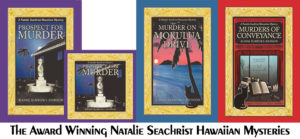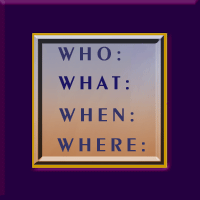
ENJOYING YOUR ADVENTURES IN PUBLISHING…
This blog first appeared on https://HometownReads.com, which I highly recommend to both readers and authors seeking to learn more about the art and business of publishing books! You can click on https://HometownAuthors.com to view a variety of articles from member authors…
As an author, you may have experienced both lows and highs if you have managed to publish a book series! It’s a true accomplishment, regardless of whether you planned it or not. But while you were promised great things would emerge at this point in your writing career, you are facing more than a few challenges. Allow me to tell you about issues I’ve confronted during the publications of Murder on Mokulua Drive, the second Natalie Seachrist Hawaiian mystery…
ELEMENTAL CONSISTENCY
Beyond avoiding copyright violation in the chapter-opening quotes I use, I guard against repetition. During pre-publication review of Murder on Mokulua Drive, I discovered I’d reused a quote from Prospect for Murder. My records of aphorisms now indicate when and where a quote is used. Also, I discovered that I changed the color of a primary character’s truck. I have since created an expanding document listing aspects of the series as well as individual characters, their work, their home, and even their pets.
CHARACTER AND LOCAL PARITY
~ Initially, I had a male protagonist. Whoops…my writers’ salon found that “voice” more appropriate to a woman.
~ Names, their spellings, descriptions, and pronunciation must all be checked. Imagine my chagrin in realizing I’d changed a name’s pronunciation mid-way through PFM’s audio edition!
~ While my protagonist thinks in whole words, she speaks with contractions. I now begin each book by reviewing my chart of persons, places, and their characteristics.
PLURALITY
Promotional text highlighting aspects of a single book must encompass each title in a series. Having multiple titles often means having different editions. For PFM, I had hardcover, softcover, Ebook, and physical and digital audio editions. MOMD is currently available in only hardcover and Ebook. I have to remember to omit audio references (like “Audible.com”) when describing the second book.
PRESENTING YOURSELF
If you have a publisher or literary agent, they may have guidelines for presenting yourself personally, online, and in traditional and social media. If you’ve never been in the public eye, you may be grateful for their suggestions about wardrobe, hair, accessories, and makeup [yes, men sometimes require makeup].
Beyond any grooming and/or behavioral adjustments you may need to make for public appearances, you will probably need to vary your public stance depending on the venue or type of media. I’m not suggesting that you become a shape-shifting chameleon, but envisioning each audience will help you view yourself as they will. For instance, wearing a suit may be ideal for some locales and audiences, but something less formal may be best for others.
MARKETING YOURSELF
Regardless of who directs your marketing, examine media kit samples to see what you should prepare. This will include bios, photos, sample media releases, and relatable stories, covering:
~ Background [family, education, career]
~ Daily Life [home, work, writing locale, pets, hobbies]
~ Writing Methodology [research, writing, editing]
~ Influential People [affecting your work and life]
~ Author Experiences
~ Changes in Your Writing
ELASTIC PROMOTIONAL TEXT
Were you initially described as a debut author? That’s no longer relevant. What other life changes will impact your self-description. Are you in a new professional position? Where do you live, or travel for research, sales, and presentations? Periodically (and in varying length), you’ll need to restructure text for:
~ Media releases about books, awards, appearances
~ Bios for ads, event programs, introductions
~ Submission of your work for reviews and contests
~ Website discussions of your life and authorship
~ Social media posts, comments, and event announcements
WELCOMING IMAGES
Gather images to stimulate the interest of colleagues, readers, listeners, and the general public including:
~ You and your normal surroundings
~ Events in which you have participated
~ Images attracting your interest
~ Organizational and community events in which you have been involved
~ Images relevant to characters, scenery, and activity in your writing
DESIGNING AND REDESIGING INVITING WEBSITES AND BLOGS
I must confess that this is a recurring theme in this blog, because the process is never complete. Working alone or with a web master, there are many aspects to consider on a regular basis. First, consider that you may have a website dating from before you became an author. Some of its elements may be recyclable…if you feel the appearance of the original site is compatible with your current work. With bios, book synopses, and pertinent images being available, much of the material you need as an author should be ready to upload. You just need to weave it all together to appropriately reveal aspects of yourself and your work. Consider:
~ Styles appealing to your target market [realism, art deco, country kitch…]
~ Colors [you like and wear; those describing your work]
~ Shapes reflecting your style and work [linear or curved]
~ Textures, natural or man-made [wood, silk, metal, stone, plastic]
Final thoughts? Well, there’s nothing final about the process of writing…or of marketing your work. As with your compositions, keeping electronic and hardcopy samples of your promotional material, will help you shape attractive representations of your unfolding life’s work!
Wishing you the best in your creative endeavors,
Jeanne Burrows-Johnson, author, consultant, and motivational speaker
Tips to enhancing your writing may be found in:
Empowering Your Words, February 2015
Creating Fictional Characters, March 2015
Sidestepping Writer’s Block, April 2015
Communicating with Every Sense, May 2015
Energizing Narrative Passages, September 2015
The Author Recycles, July 2017
Balancing Text & Space, February 2017
Book Series Adventures, April 2018
Drawing on Sense Memories, July 2018
To learn more about the award-winning Natalie Seachrist Hawaiian Mysteries, including Murders of Conveyance [Winner, Fiction Adventure-Drama, 2019 New Mexico-Arizona Book Awards] and other projects, please drop in at my author’s website JeanneBurrows-Johnson.com. You’ll even find Island Recipes that might inspire your culinary creativity.
For more ideas to strengthen your Wordpower© and branding, please visit: Imaginings Wordpower and Design Consultation.
Follow Me:
Amazon, Arizona Authors Association, Apple Books
Audible, Authors Den, Barnes and Noble, Blogarama, Book Bub
Cozy Mysteries-Unlimited, Facebook, Good Reads, Hometown Reads
Book sellers may contact book distributors such as:
Baker & Taylor, Follett, IPG, Ingram, Mackin, Midpoint, TitleWave



